

Bali Wants To Redefine What Cultural Tourism Means In 2024
Posted on Published: January 13, 2024
Share The Article
- Facebook 76
One of the top reasons tourists cite when asked about why they want to visit Bali is the culture.
The Island of the Gods is home to one of the most unique cultures in the world, but some leaders feel tourism is starting to threaten its longevity.

Officials in Bali have come together to discuss the future of tourism on the island.
As leaders have been calling for a shift towards more sustainable and culturally respectful tourism, following a rise in badly-behaved foreigners in 2023, there is an opportunity for Bali to redefine what cultural tourism means in practice.
At a summit titled ‘Continuous Bali Tourism Development Meeting Challenges and Solutions’ the island’s leading tourism stakeholders came together to redefine what Balinese cultural tourism must look like moving forward.
They also discussed how to tackle the internal and external challenges tourism and culture experience on a small and large scale.
View this post on Instagram A post shared by Wonderful Indonesia (@wonderfulindonesia)
The meeting was chaired by Regional Representative Council Member Made Mangku Pastika who has proposed that the redefinition of cultural tourism must come before any further changes to the tourism sector are made.
Pastika told reporters about the challenges tourism in Bali is facing at this time.
He explained, “External challenges include the length of stay of foreign tourists which is getting shorter because more and more foreigner tourists from Bali then continue their journey to Labuan Bajo and Lombok.”
View this post on Instagram A post shared by 𝙍𝙀𝙂𝙀𝙉𝙀𝙍𝘼𝙏𝙄𝙑𝙀 𝙏𝙊𝙐𝙍𝙄𝙎𝙈 𝙄𝙉 𝘽𝘼𝙇𝙄 (@astungkaraway)
He noted that traffic congestion, waste management, and crime are also issues that need great attention and resources if Bali’s tourism sector is to uphold its reputation worldwide.
These are all issues that officials in Bali are openly acknowledging need to be addressed urgently.
Pastika and his peers also discussed the issue of over-tourism, though they rejected the statements made by the World Travel and Tourism Council report that claimed the island has already reached the point of over-tourism.
The report also stated that Paris, Venice, Athens, and Phuket have all toppled over the precipice into overtourism.
View this post on Instagram A post shared by Bambu Indah (@bambuindah)
Tantowi Yahya, the President Commissioner of Kura Kura Bali, told reporters how cultural tourism has changed in recent years.
Yahya explained “Now Balinese culture has changed a lot. For example, many Balinese dances are no longer accompanied by a live gamelan. There are also fewer and fewer green open spaces. I hope that the Governor of Bali in the future will have a policy that is in favor of sustainable tourism.”
The Acting Governor of Bali, Sang Made Mahendra Jaya, was also in attendance at the conference.
He called for a united approach to promoting cultural tourism in Bali and noted that this unity could have an impact bigger than the sum of its parts.

Acting Governor Mahendra Jaya said, “Changes occurring in Bali’s tourism climate require the involvement of all parties to help maintain the sustainability of Bali tourism.”
“As hosts, our duty is to maintain and preserve all the tourism potential that we have, then provide good service to all tourists, in accordance with the cultural customs we have so that tourists feel safe and comfortable traveling in Bali.”

The Acting Governor concluded “In an effort to maintain the sustainability of Balinese cultural tourism I invite all parties to collaborate together to carry out tasks according to their respective roles in maintaining the preservation of Balinese culture, preserving Bali’s natural environment and improving the quality of Bali’s human resources.”
There are dozens of businesses and initiatives in Bali that focus on promoting Balinese and Indonesian culture in a respectful and sustainable way to tourists.
It is entirely possible to visit Bali and experience the island away from the tourism offerings that cater to the mass market.
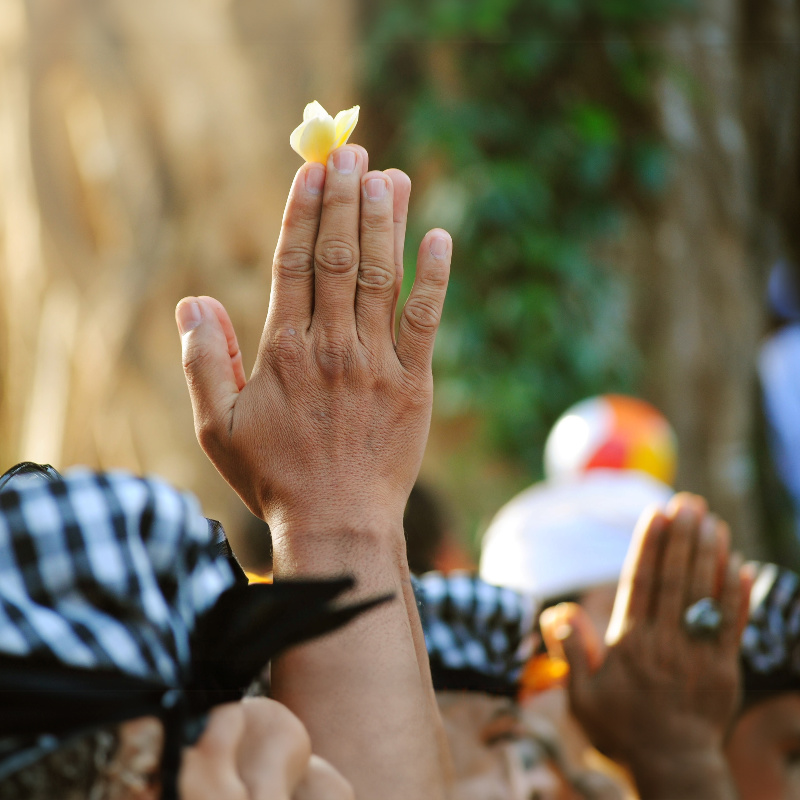
Whether it’s respectfully visiting lesser-known villages and temples, staying at locally run honesty’s or even top eco-hotels, and opting for excursions and activities that focus on farming, connecting to the land, and learning about Balinese culture in a reverential and respectful way, there is so much potential for culturally respectful and sustainable tourism as default in Bali.
Organizations like Potato Head Bali, Mana Earthly Paradise, Astungkara Way, Usada Ubud, Bambu Indah, and so many more have been blazing the trail for sustainable and regenerative tourism for all.
Remove All Ads & Unlock All Articles… Sign up for The Bali Sun Premium

Plan Your Bali Holiday: Book The Best English Speaking Drivers For Airport Transfers & Tours Choose From Thousands of Bali Hotels, Resorts, and Hostels with Free Cancellation On Most Properties Book Cheap Flights To Bali Don’t Forget Travel Insurance That Covers Medical Expenses In Bali
For the latest Bali News & Debate Join our Facebook Community
SUBSCRIBE TO NEW POSTS
Enter your email address to subscribe to The Bali Sun’s latest breaking news, straight to your inbox.
Enter your email address
Robert Sablin
Monday 15th of January 2024
They redefining it daily, cutting down all the ancient holy trees, plowing the beautiful river valleys for more resorts, you name it they are redefining what Bali used to be.
Sunday 14th of January 2024
Upping the spa tax to 40% will make sure less money for "spiritual tourism" and more money are diverted to the beach club tycoons.
More useless jaw-clapping from Bali.
Talks about sustainable tourism - destroys another area of nature into shitty dirty concrete junge. Talks about respectful tourists - builds more day and night clubs for drunken yobbos. Talks about waste management - turns rice fields into open garbage dump.
Bali is a circus.
Saturday 13th of January 2024
To late and to late way to late Serangan kurakura ??? It was the only and best location for a waste processing recycling plant. The perfect opportunity to show the world how Bali is in balance with nature 🙏
They want it BOTH ways: More tourists AND less congestion. Too late now..... Ain't gonna happen!
The hunt for the next Bali: Inside Indonesia's plan to save its tourism industry by minting 5 new hubs for international travelers
Land of holy temples, age-old traditions, beaches and jungles — and hordes of influencers in flowing white clothing .
The vacation hotspot is one of 17,000 islands that makes up Indonesia, the largest archipelago in the world. Its verdant rice terraces and Hindu temples define its landscape and make it catnip for the Instagrammers and tourists who flock to the island every year.
In 2019, Indonesia welcomed 16.1 million foreign tourists, according to data from the country's central bureau of statistics. Bali's Ngurah Rai International Airport saw 6.23 million foreign arrivals that year, the most of any airport in the country. While some would argue that tourism has "ruined" Bali, it has become an indispensable part of the island's economy: An estimated 80% of Bali's economy is tied to travel.
The pandemic, of course, ground tourism to a halt globally, and Indonesia was no exception. In April 2020, foreign arrivals in Bali dropped by more than 93%. In the same month, the government announced the pandemic was forecast to wipe out $10 billion from its tourism revenue by the end of the year. By November, Indonesia announced it was in its first recession in 22 years.
Now, the government is trying to kick start tourism with a series of proposed measures that include travel bubbles between several of its islands and nearby Singapore, and a five-year visa targeting business travelers and digital nomads.
It's also planning to spend $275 million on 108 infrastructure projects this year to mint a series of "new Balis," a sweeping initiative that aims to bring tourists to new parts of the vast country.
But all that development comes at a cost. Insider spoke with economists as well as tourism and Southeast Asian development experts to understand what kind of downsides a new surge in tourism could create. Some of those experts expressed doubt that the appeal of Bali can be replicated in the first place — while others are concerned about the impact widespread tourism will have on the country's people and environment.
One of those experts, Jaeyeon Choe O'Regan, who has a Ph.D. in tourism management and focuses on sustainable community development and poverty alleviation in Southeast Asia, told Insider the project raises a series of red flags.
"I'm concerned about replicating the idea of Bali in these provinces because they have characteristics, resources, heritages, and people that are totally different from Bali," Choe O'Regan said.
Indonesia launched its plan to replicate the success of Bali years before the pandemic.
President Joko Widodo described the plan to a group of businessmen during a trip to Hong Kong in May 2017: "You all know Bali, our famous island paradise? With improved infrastructure, we will launch a program called 10 New Balis."
Last year, the government narrowed that list down to five "super priority" locations, which were selected based on their accessibility, their viability as tourism destinations, and the presence of a pre-existing tourism scene to build on.
The list includes:
- Borobudur, the world's largest Buddhist temple, which dates back to the 8th century. It was restored in the 1970s, and is located in South Java.
- Mandalika, a resort area that was designated a Special Economic Zone in 2014. It's located on Lombok, an island that neighbors Bali, and is set to be the host of the Grand Prix Motorcycle race ( MotoGP ) later this year.
- Labuan Bajo, a fishing town that's known as the gateway to the home of the Komodo dragon.
- Lake Toba, a large lake in North Sumatra that sits in the caldera of a volcano.
- Likupang in North Sulawesi, a popular diving and snorkeling site.
Luh Putu Mahyuni, a Balinese associate professor of management accounting at Universitas Pendidikan Nasional (a private university in Bali) and a Ph.D. in sustainable business and economy, told Insider that Indonesia's approach to selling each location as a tourism destination will likely vary.
"The central government will sell Lake Toba for the beauty of its nature — they will sell eco-tourism," she said. "In Borobudur, they will sell the temples, so it's historical and cultural tourism."
She also pointed out that even with the natural and cultural resources across these destinations, not all elements of Bali are replicable — particularly when it comes to religion. While Hinduism is practiced by less than 2% of Indonesia's total population, it's practiced by almost 87% of people in Bali, per data from the country's central bureau of statistics.
Bali is also home to more than 20,000 temples, according to a 2014 paper called "The Readiness of Bali as Spiritual Destination" released by a team of French and Indonesian universities. Between its myriad temples and its many wellness clinics and yoga retreats, the island has become a magnet for tourists who like a little spirituality with their vacation.
"Basically, the 'new Balis' are dependent on natural beauty and some history. But Bali is known for richness of culture — in Bali, you can find a living culture that is closely related to religious practices, which you will hardly find in other areas in Indonesia," Luh Putu said. "This is the one that is missing in the 'new Bali' [scheme]."
In a 2019 report for the Organization for Economic Cooperation and Development (OECD) focusing on Indonesian tourism, economists Patrice Ollivaud and Peter Haxton laid out the government's tourism goals. Those goals focused on getting as many people to visit as possible.
"Initially [the government] was focusing on attracting more and more tourist numbers," Ollivaud told Insider on a phone call. "That gradually changed."
A representative for the Indonesian government told Insider the strategy for 2021 is not tied to the number of visits, but instead prioritizes "tourists who have a high income."
But even as the program's focus shifts away from mass tourism, the locations may still collectively have their work cut out for them, as indicated by the World Economic Forum's (WEF) 2019 Travel and Tourism Competitiveness report.
When it comes to tourism infrastructure and as compared to Asia Pacific nations, Indonesia ranked in the bottom 40% of the WEF report. And while it scored high on the WEF's ranking of price competitiveness (No. 6 of 140 countries total) and prioritization of travel and tourism (No. 10), the county is lagging in tourist service infrastructure (No. 98) and in environmental sustainability (No. 135).
In other words: It's an inexpensive country to visit, and the government is focused on tourism — but the infrastructure to receive those tourists is weak, and the government's environmental regulations to protect natural resources are very weak.
As the authors of the 2019 OECD report put it, "Infrastructure needs are enormous compared to government funding capacity."
Closing the accessibility gap
So, what does it take to turn an area into a "new Bali?"
For one thing, there's the matter of physically getting to each location.
"The government is currently focused on infrastructure, because the connectivity from Bali and Jakarta to these five new Bali destinations is very bad," Luh Putu said. "That's the biggest challenge."
Both the island of Lombok (on which Mandalika is located) and Labuan Bajo have small international airports, but Luh Putu said the roads linking the airports to their destinations need to be improved. Borobudur is a two-hour drive from the closest airport in Jakarta, a city where the traffic has been described as a " nightmare ," while Lake Toba is a four- to five-hour drive from the closest airport.
Likupang, known for its snorkeling and diving, is the area that faces the biggest developmental challenges due to limited infrastructure and tourist attractions, as well as the lack of good internet access, the representative for the Indonesian government said.
Bali, on the other hand, is home to Indonesia's second-biggest airport by airline count: Ngurah Rai International has two terminals and receives direct international flights from hubs including Beijing, Singapore, and Sydney. The airport is a 40-minute drive from tourist hotspot Ubud and a 10-minute drive from the Bali party town of Kuta.
To fill the accessibility gap between Bali and the would-be Balis, the government said in an April press release that it would be allocating part of its spending on connectivity. In the case of Mandalika, for example, part of the area's budget is being used to connect Mandalika to Lombok airport. In Lake Toba, part of the budget is going towards road and bridge upkeep, and in Borobudur, it will be used for flood control infrastructure.
But, as Choe O'Regan, the Ph.D. who focuses on sustainable community development, said, "It's not just the roads and the airports."
Ollivaud echoed the same idea: "Transportation is an important part of the deal. But there's also all this other environmental infrastructure that's very important and often lacking in Indonesia."
At the core of the plan to replicate Bali as a tourism model is a basic and pervasive problem: Succeeding could be harmful to local people and local environments, both Ollivaud and O'Regan said.
"Pollution is becoming a huge problem for Indonesia, not only plastic but also having proper water is an issue," Ollivaud said.
"Replicating Bali is a bit of a dangerous idea," said Choe O' Regan. "Bali has serious issues — water shortage, garbage management, people pushed out of villages and homes because of fancy resort development."
In December 2017, the island declared a "garbage emergency" and three-and-a-half miles of beach were deemed an emergency zone because they were so overrun with plastic waste. (The government representative said Indonesia is targeting a 70% reduction in marine debris by 2025.) It's also experiencing a water crisis that's driven in part by its popularity as a tourist destination.
Development plans in Mandalika — which, as a Special Economic Zone, is attracting foreign investment in addition to government investment — in particular, have raised red flags overseas. In March, UN human rights experts urged the Indonesian government to respect human rights after sources found local people were forced off their land without compensation. The Indonesian government representative told Insider it rejects the UN's concerns, calling them "false and hyperbolic."
Ollivaud and Choe O' Regan also both pointed to the importance of developing vocational training programs in the new tourism areas so that locals can find employment, and not only in low-income positions.
"Local people usually get hired for cleaners, receptionists, drivers. These developments generally make low-income jobs for local people," Choe O' Regan said.
Luh Putu, the Balinese professor, is more optimistic. She said the new locations are being developed with Bali's issues in mind: "The government learned a lot from the case of Bali tourism. They realized mass tourism generates a lot of negative impacts on the environment."
She went on to note that Bali's model of tourism is evolving, too, and pivoting towards a village-tourism model in which income is generated in and kept among the local communities.
"If you come to Bali right now, there's a lot of tourism based around villages that's more sustainable in terms of the environment and the culture," Luh Putu said. "Tourists are invited to experience living like a villager to interact with the local culture."
Emerging from the pandemic
Some indicators show the initiative was succeeding in drawing tourists into the new locations before the pandemic struck.
Borobudur and Lake Toba, for example, emerged as new tourism destinations in Indonesia in recent years, per the OECD report. Construction projects including zoning, road construction, and waste management have been ongoing throughout the pandemic in all five locations, the government representative said.
But while the initiative is riding on Bali's international renown to attract tourists, the question still remains whether the island's innate appeal will rub off on other Indonesian destinations.
"Even though they have marketing plans, I don't know how they will actually attract tourists to these locations," Choe O'Regan said. "I think people will still prefer to go to Bali."
And independent experts and government officials alike acknowledge that the stakes are high with this latest tourism push. Luh Putu said that success across the new destinations would bring some much-needed stability to Indonesia's tourism sector.
"Currently, most of Indonesia's tourism income comes from Bali," Luh Putu said, referencing pre-pandemic information. "If the five destinations are a success, it will improve the resilience of tourism because the country won't only be dependent on Bali for income."
On the flip side, Basuki Hadimuljono, Indonesia's minister of public works and public housing, identified what's at stake should the program fail.
"For tourism, first the infrastructure must be repaired, then amenities and events, then a massive promotion," Hadimuljono said in an April press release. "If that's not ready, tourists come once and won't come back again."

Related stories
More from Travel
Most popular
- Main content
- International edition
- Australia edition
- Europe edition
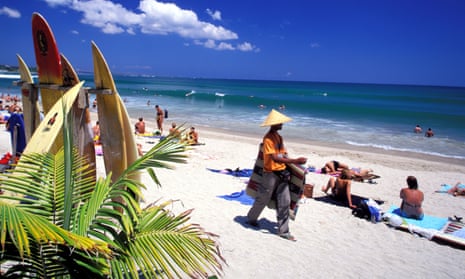
Bali is reopening to tourists, but nervous locals wonder what the future will bring
The pandemic has prompted a rethink of tourism’s role on the island as some call for only ‘quality’ visitors
After being shuttered for 17 months, the upmarket Hujan Locale restaurant in the Balinese town of Ubud is slowly coming back to life.
Outside, staff greet a box truck driver who delivers fresh vegetables and stacks of lemongrass, ginger flowers and kaffir lime leaves. Kitchen workers are busy preparing for the day ahead. A chandelier above a stairway is once again casting a warm yellow shimmer across the walls.
Before the pandemic, Hujan Locale was a thriving business that served local dishes – including bebek goreng, Balinese fried duck with mango chilli sauce, and tongseng kambing, central Java’s slow-braised lamb wrapped in cabbage – to foreign tourists. Covid, and a ban on foreign travellers introduced late March 2020, destroyed its income. The restaurant used to employ 50 staff members; now there are just 15.
There are, however, some signs of hope.
On Thursday, Bali is due to reopen to travellers from several countries including China, Japan, South Korea, New Zealand, and the United Arab Emirates. Visitors will be required to follow certain regulations – they need to be fully vaccinated and take two PCR tests, both before their flight and on arrival. They will also need to quarantine. Initially, officials said people must do so for eight days on arrival, but a last minute announcement this week reduced the requirement to five days.
“Everyone’s been waiting for this. Tourism is the backbone of Bali,” said Hujan Locale’s manager, Kadek Miharjaya.
Bali, Indonesia’s main tourism hotspot, drew more than 6 million travellers in 2019. But since the start of the pandemic, the streets in Ubud, which would normally be filled with tourists, have been empty. Many businesses are closed, and the area is peppered with “for rent” signs.
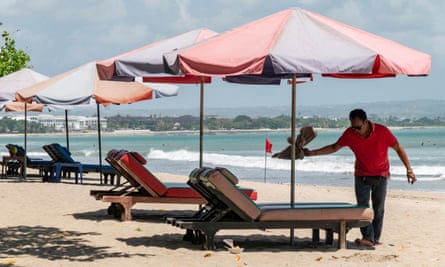
The plan to partially reopen Bali is a first step towards reviving the tourism industry, which contributes more than 50% of the island’s income , according to the UN World Tourism Organisation.
‘We do not want backpackers’
The pandemic has prompted a debate about the role of tourism in Bali, with some arguing the island should become less dependent on the sector and instead develop other areas of the economy. Reports of foreign tourists who remained on the island during the pandemic but refused to follow health protocols has added to such sentiments. This week, Bali’s governor said that tourism had benefited “a handful of people, especially foreign investors”, but not the general public. He said he instead planned to promote areas such as cultural crafts, agriculture and fisheries.
Government officials have spoken of the need to alter the tourism sector to focus on attracting “quality” tourists. Luhut Pandjaitan, the coordinating minister for maritime affairs and investment, said last month that the authorities would “filter” tourists. “We do not want backpackers,” he said.
Bali Tourism Agency head I Putu Astawa says the island is hoping to receive travellers who will spend more money, stay longer and have a better attitude.
He pointed to foreigners who have not complied with Covid guidelines, who have abused their tourist visas by working illegally, or broken the law in other ways. “Those are parasites that we need to put in order and keep an eye on,” Putu Astawa said.
Bali has fully vaccinated 80% of the eligible population, according to president Joko Widodo – ahead of much of the country. Cases have fallen from a peak of about 1,000 a day in July . On Monday, there were 37 new cases and seven deaths.
Many residents who work in tourism say they aren’t expecting a boost in business any time soon. Some worry that few tourists will want to undergo quarantine. Others fear the government strategy, which seems to focus on attracting the wealthiest visitors, will only benefit certain types of businesses.
“What about smaller businesses such as homestays? Who’s going to stay there?” said Kadek Kerta Rusmana Yasa, 33. He used to work as a resort manager in Ubud and, at one point, could make 10m rupiah ($700) a month. As the pandemic hit the island, the resort eventually closed for business and he began to work as a moto-taxi driver for ride-hailing firm Grab. He is married with two children, including a baby born during the pandemic, but now can only make about 50,000 rupiah ($3.50) a day. The minimum wage in Bali in 2021 is about 2.5m rupiah ($175) a month.
“Travellers from middle classes will find it difficult to afford quarantines,” Yasa said. “Many foreigners who come here for honeymoons are not exactly rich people. In fact, rich people rarely tipped – based on my experience.”
Yasa hopes the government will stop referring to “quality tourists” altogether. “Those with more money can also do crime and disrespect the island. What’s more important is the law enforcement,” he said.
Arie Yuniarti, 43, who is originally from Surabaya, East Java, and worked as a travel consultant in Sanur, Bali, is also feeling pessimistic. “I don’t want to get my hopes up,” said Arie. She has since opened a small grocery store.
“Only people who really, really need to come to Indonesia who will come to Bali,” she said. She agrees that, given the barriers to tourism, there are other sectors that should be developed. “But it will require brilliant ideas and time to change the mindset of the people,” she added.
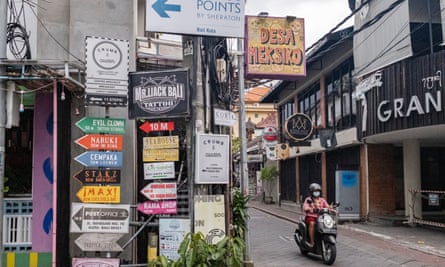
Many of the staff at Hujan Locale resorted to other means to make ends meet – from selling snacks online to returning to their villages to become farmers.
Miharjaya said the restaurant has had virtually no income since the start of the pandemic. Management could only just manage to pay for the remaining staff members’ universal healthcare.
“[Staff] lived without a monthly salary, but we tried to at least cover their insurance including their families’ insurance as well,” Miharjaya said.
Back at the restaurant, which reopened on 1 October, a trickle of customers slowly arrive through the doors. “I can’t believe this place is open again. I was so sure they would be out of business and never coming back [after] a year-and-a-half closed,” said one diner, Jared Collins, an artist from New York.
But as it is for many businesses in Bali, Hujan Locale’s future is uncertain. Before the pandemic it would serve as many as 100 diners each day. Since reopening, it typically attracts between 10 and 20 people. “We’re still in a grey area whether we’ll open long term or short term,” said Miharjaya.
- Coronavirus
- Asia Pacific
Comments (…)
Most viewed.

How Bali could build a better kind of tourism after the pandemic
Senior Lecturer in Tourism and Leisure, Bournemouth University
Professor of Marine Biology and Conservation, Bournemouth University
Disclosure statement
Rick Stafford receives research funding from Interreg Europe and the Earthwatch Foundation
Jaeyeon Choe does not work for, consult, own shares in or receive funding from any company or organisation that would benefit from this article, and has disclosed no relevant affiliations beyond their academic appointment.
Bournemouth University provides funding as a member of The Conversation UK.
View all partners
COVID-19 has hit tourism-reliant destinations hard . The Indonesian island of Bali, for example, where 70% of the population depend on tourism , has seen extensive job and income losses since it closed its borders in April.
The economic impact so far has been greater than that of the Bali bombings of 2002, with losses of around 9.7 trillion rupiah (about £551.3 million) a month.
In the past, the island’s image as a peaceful paradise with a rich cultural and religious heritage has made it a highly resilient tourist destination. Bali recovered swiftly in the wake of past crises, both natural and man made, including the Gulf War (1990), a cholera outbreak (1995), Sars (2003) and bird flu (2007).
But without significant investment and diversification, there are widespread concerns that this crisis could be different .
A different approach may now be needed to save the tourism industry – and to make sure its benefits are more evenly spread. We believe that now is the time to adjust the model in Bali away from surf, parties, and yoga towards rural villages with high poverty rates across the island (especially the underdeveloped north-east).
To do this, government support is required to build small-scale tourism that will provide new livelihoods. This might include everything from dolphin watching and snorkelling trips, to food tourism and “experience tourism” focused on traditional fishing and farming.
Read more: African tourism has been put on ice by coronavirus – here's how some countries are reviving it
That support does not necessarily need to be in the form of cash. When we interviewed small-business representatives in Bali last year, they called not for financial subsidies, but for marketing training and access to tourism-research data.
As one entrepreneur told us: “Many local creative businesses are managed as informal family businesses. They lack knowledge in professional management and marketing skills.”
He also spoke of the need for improved collaboration between IT experts, business consultants, local universities and policymakers.
Yet there are important risks to consider when attempting to build a new kind of tourism. “Authentic” experiences can often be manufactured by large businesses, preventing regional economic development (other than occasional low-paid work) in the most deprived areas.
And without investment in tourist infrastructure, it would be too easy for tourists to prefer the manufactured version over the true “authenticity” on offer from local communities. Carefully considered investment, however, could lead to sustainable development.
According to Dr Luh Putu Mahyuni, a sustainable business consultant and economist at Undiknas University: “The pandemic provides a wake up call for Bali to foster […] new types of tourism such as gastronomic tourism.”
She told a webinar we hosted in May: “The tourism sector needs to develop products with other sectors so as to create a more resilient and sustainable economy.”
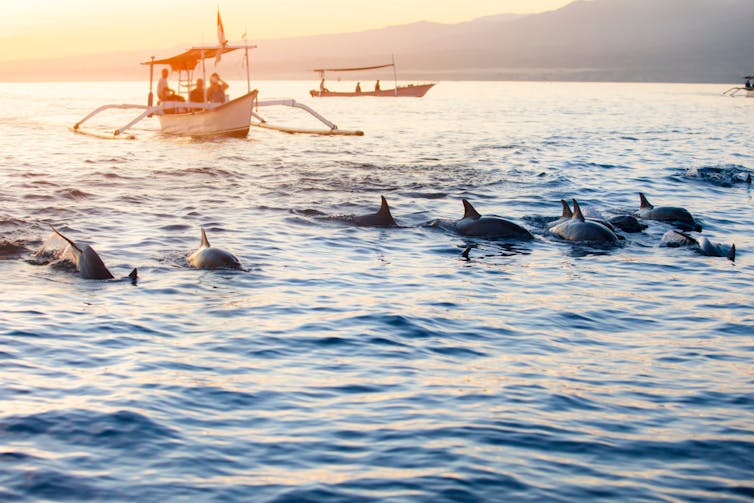
To boost that economy, the island should also consider a tourist tax, while reducing taxes on small-scale home-stays, and better regulating the presence of Airbnb. It also needs to restrict foreign ownership of property, limit destruction of viable farmland and limit business sizes in the south of the island.
An island of opportunity
Notwithstanding all the devastation it has caused, COVID-19 has given the world an opportunity to pause and reflect on how things may change in its aftermath . The tourism industry in Bali (and many other places) is no exception.
For tourism is often seen as a solution to all kinds of problems, from economics to conservation. But as our research has shown, unless tourist money is kept in the local community, the benefits do not materialise .
And besides the major financial concerns on Bali, and the need for a tourism-led recovery, the authorities must also face up to deeply entrenched levels of structural inequality. Poverty, homelessness and dispossession existed long before the pandemic.
The island must learn from what happened 18 years ago, when the bombings led to job losses and increased rates of depression, alcoholism and crime . And we hope that Bali can use the current crisis as an opportunity to look at the causes of such social problems, rather than the symptoms . To move on and build a more resilient island, where responsible tourism plays a major role in alleviating poverty.
- Bali bombing
- Coronavirus

Senior Lecturer - Earth System Science

Operations Coordinator

Sydney Horizon Educators (Identified)

Deputy Social Media Producer

Associate Professor, Occupational Therapy
Your Trusted Visa Agent in Bali
The Evolution of Bali’s Tourism Industry: Sustainable Initiatives and Future Prospects

Introduction
As Bali’s renowned tourism industry evolves, sustainability has become a focal point, reshaping the way visitors experience this tropical paradise. In this post, we’ll delve deeper into the latest sustainable tourism initiatives in Bali and forecast their impact on the future of travel in the region.
Sustainable Tourism in Bali: Current Trends
Bali is witnessing a significant shift towards sustainable tourism. This includes eco-friendly accommodations like the Green Village in Ubud, which offers a unique experience with its bamboo architecture and focus on green living. Additionally, Bali’s plastic-free zones, particularly in areas like Ubud and Canggu, are testament to the island’s commitment to environmental preservation. The coral reef restoration project in Amed is another significant effort, involving local communities and organizations to rehabilitate marine life.
Community-Based Tourism: Empowering Local Communities
Community-based tourism is gaining momentum in Bali. A prime example is the Tenganan Village in Karangasem, where visitors can experience the traditional Balinese way of life and purchase authentic crafts directly from the artisans. Another noteworthy initiative is the Jatiluwih Rice Terraces, a UNESCO World Heritage site, offering tourists a glimpse into Bali’s agricultural heritage while supporting local farmers.
Future Prospects: Balancing Growth and Sustainability
Looking ahead, Bali faces the challenge of balancing tourism growth with environmental sustainability. The development of sustainable tourism models will be crucial to accommodate increasing tourist numbers without compromising the island’s natural and cultural assets. Sustainable transport options and renewable energy sources will play a key role in this balance.
Bali’s tourism industry is at a pivotal point, with sustainability at its core. These initiatives not only enhance the visitor experience but also ensure the preservation of Bali’s natural beauty and cultural heritage for future generations. As we navigate this exciting journey, the potential for a more responsible and sustainable tourism model in Bali is immense.
Dewi Owner, RevisBali Your Trusted Partner in Navigating Bali’s Immigration Landscape
Tourists gone, Bali’s young entrepreneurs eye sustainable future
Young people on Indonesia’s famous resort island are finding new ways to make ends meet after the collapse of tourism.

Ubud, Bali – When Made Yogantara lost his job after COVID-19 sank Bali’s tourism industry , he had to get creative to take care of his family.
Made, who worked at a popular tourist restaurant, enlisted the help of his uncle – a lecturer in agriculture – and turned a vacant lot owned by his family into a small farm. Nearly two years later, the 26-year-old former bartender is selling organic fruits and vegetables online and at the site.
Keep reading
Endless pandemic asia’s omicron retreat shows covid is political, ‘under attack’: report says repression of rights persists in asia, abd trims developing asia’s growth forecast on omicron fears, flush with vaccines, asia sees return to normal slip out of reach.
The 25 square metre (269 sq feet) permaculture garden, I Think Fresh Urban Farms, has enabled Made to stay afloat during the pandemic and even donate more than 20kg (44 pounds) of fresh produce to a recent relief effort for the island’s vulnerable communities.
Before the pandemic hit, Made never thought of venturing outside of hospitality, which in normal times would experience a year-end rush that allowed workers to double or triple their monthly wage. Like many of his peers, he saw few other opportunities for young people on Indonesia’s popular resort island.
“But now young people in Bali will really need to explore. We see and experience it ourselves that we can’t rely too much on tourism,” Made, who was furloughed for seven months before being let go, told Al Jazeera.
Made is far from alone.
In 2020, 236,000 people in Bali worked in the tourism sector, compared with 328,000 the previous year, according to data from Indonesia’s Ministry of Tourism and Creative Economy. That number is unlikely to have improved much in 2021. Despite reopening to international arrivals in October , the island welcomed just 45 tourists in the first 10 months of this year, according to the Central Statistics Bureau of Bali, compared with more than six million international visitors and 10 million domestic tourists in 2019.

The collapse has left young people, in particular, seeking out new ways to make ends meet, according to Irma Sitompul, the co-founder of the Pratisara Bumi Foundation, which runs a nine-month business incubator called INKURI for youth on the island.
“For Bali in particular, we’ve seen how the youth have really struggled,” Irma told Al Jazeera. “Most of the workforce here depends on their income in tourism, and since the sector is hit the hardest, many have become unemployed and aren’t able to find alternative livelihoods.”
“They are also looking for alternatives to tourism because they have seen first-hand how destructive the effect of mass tourism is in Bali, how their ancestral lands are being turned into villas, and how the island is sinking with waste pollution,” Irma added.
Irma, whose nonprofit organisation helps communities set up businesses that prioritise sustainable practices, said the pandemic had inspired many young people to think about starting a small business at home.
“We have 276 applicants, all between 18-32 years old, at the start of the programme. 45 percent of the participants are still in school,” said Irma.
Sustainable biomaterials
Now at its second phase, the incubator is focusing on 23 entrepreneurial ideas, nearly half of which centre around agro-food businesses. Less than one-third are related to tourism.
Gede Abdi Setiawan, one of the incubator participants, became convinced he was meant to be an entrepreneur after seeing his mother lose her job as a spa therapist early on in the pandemic. After a stint working at a hotel, the 22-year-old agro-technology student hopes to develop a freshwater eel farm in his village in Negara, West Bali.
“Rice field eels, specifically,” Abi told Al Jazeera in between INKURI sessions, speaking excitedly about the eels’ value as a foodstuff in his community. “Balinese love eel crackers. They were very popular when I was growing up, sold in almost every roadside food stall. But now that plenty of rice fields in Negara have been converted into buildings, they are becoming more and more scarce.”
Kadek Mesy Wulandari, another INKURI participant, is keen to turn corn husk waste in her village in Klungkung, East Bali into sustainable biomaterial. Mesy, 26, believes her idea could help young people in her village find work. “Nearly everyone in the village – mostly working for cruise ships, hotels, restaurants – is still unemployed. We’re looking to change that,” Mesy told Al Jazeera.

But after decades of building up the industry, Bali is likely to find it an uphill battle to transition away from tourism, according to industry expert Gede Sutarya.
“In 1971, the Indonesian government decided to make Bali an international tourism destination. They welcomed foreign investments, built many hospitality training schools on the island, and then saw the tourism numbers target continue to rise,” Gede told Al Jazeera, explaining that arrivals from overseas ballooned from about one million in 1994 to more than six million in 2019.
“To keep up with the climbing numbers, Bali started seeing overdevelopment of foreign hotel chains and villa complexes, often at the peril of locally owned homestays and small businesses. In 2011, there was a moratorium on new hotels in South Bali, but this had little to no effect.”
Gede said the population would continue to see tourism as the main source of jobs until the government put a brake on the rampant development of hotels and villas.
“For older generations … that’s all they know,” he said. “They were there at the beginning of Bali’s plunge into tourism, watched it thrive, and built their career around it. They want the same thing for their children.”
Social expectations
For young Bali residents such as Made, Abdi and Mesy, social expectations are still weighted towards tourism-reliant sectors such as hospitality.
“People thought that it was strange that I chose to study to become a farmer, encouraging me to work in tourism instead,” said Abdi, explaining that many older people associate farming with poverty and hardship.
“But Bali used to have a strong agricultural culture, and there is vast potential in agribusiness. This is something I believe in, and I will work to make it happen.”
Irma firmly believes that change can begin with the young.
“They have the power to shape the country’s future, so we want to make sure that our youth are equipped with the right tools,” she said. “Our goal is to see them empowered in developing their villages in a regenerative way to achieve economic resilience.”

Indonesia Sets Tourism Targets for 2023

Speaking during a visit to Jembrana Regency in Bali on Thursday, 29 December 2022, Indonesian Minister of Tourism and the Creative Economy, Sandia Salahuddin Uno, urged West Bali to strengthen its readiness for the onslaught of tourists that will result in the opening of a toll road connecting Denpasar and Gilimanuk. The Minister said future developments will help achieve a more equitable distribution of tourism across all Bali areas that are now overly focused on the south and east of Bali.

The Minister underlined how the new toll road scheduled for completion in 2025 would impact Bali’s development. Adding: “We need to get ready because Jembrana will be along the toll road connecting Denpasar and Gilimanuk. We must prepare a tourism ecosystem as many things will soon be relocating to West Bali.”
Commenting separately and quoted by Beritabali.com, Minister Sandiaga reminded his listeners that Bali remains foremost in the world’s mind as a tourism destination. He urged that Bali’s sustaining popularity be used to the optimum. Adding: “This is the basis of our continuing optimism; the tourism ecosystem and creative economy must be prepared, starting now. This is our homework so that tourism recovery takes place more equitably, emphasizing quality and sustainability.”
Tourism Targets for 2023
Minister Sandiaga said that the target for domestic and international tourists in 2023 is projected to double the current performance. For international tourists in 2023, Indonesia aims to welcome 7.4 million visitors, while domestic travelers are expected to hit between 1.2 and 1.4 billion movements.
Sandiaga said: “All tourism and the creative economy operators must address these (targets). Don’t let us get left behind! We must prepare to create new business opportunities that create the widest employment opportunities.”
- Email this article
- Print this article
Bali Update Editorial Team
Related posts.

Q1 24 Bali: Refused Entry & Deportations

Kuta Ranks among “Cheapest” Destinations

In Bali, The Early Worm Gets Eaten

IndiGo Air Now Goes Weekly to Indonesia

Hatten Wines: A Bountiful Bali Business

PwC Indonesia Firm Profile

Indonesia's Carbon Pricing

Global Annual Review 2023

Power in Indonesia

Indonesia Electric Vehicle Consumer Survey 2023

Global M&A Industry Trends: 2024 Outlook

PwC Indonesia Mergers and Acquisition Update 2023

PwC's Global NextGen Survey 2024

PwC’s Global Risk Survey 2023

Indonesia Economic Update

Global Entertainment and Media Outlook 2023–2027
Loading Results
No Match Found
Foreign tourists expected to return to Bali hotels in 2024
This article has been translated by PwC Indonesia as part of our Indonesia Infrastructure News Service. PwC Indonesia has not checked the accuracy of, and accepts no responsibility for the content.
Bisnis.com - Turis asing diperkirakan kembali penuhi hotel Bali pada 2024
10 November 2021
Jakarta – Chairman of the Bali Hotels Association Jean Hélière predicts that the global market for the domestic tourism industry will recover around 2024 to 2025. Jean said tourism businesses in Bali are still focused on maximising income from local tourists as a number of community activity restrictions are relaxed.
"We discussed with a number of experts [and] we think the global market will recover in terms of occupancy rates in 2024 to 2025, we realise that it will take time to return to the international market," said Jean in a PwC Indonesia webinar, Wednesday (10/11/2021).
As a consequence, said Jean, a number of hotel managers on the Island of the Gods are improving their services to meet the demands or needs of domestic tourists. For instance, he gave an example, business actors have recently optimised requests from domestic Meetings, incentives, conferencing, exhibitions or MICE. In addition, there is an increase in hotel occupancy rates from domestic tourists towards the end of this year.
“In 2019, the MICE market share in Bali was 60-70 percent dominated by domestic, the rest was from Singapore, Australia to China. Domestic MICE in this industry comes from the government, so I think this sector will recover faster, followed by the international market next year," he said.
Previously, the Central Statistics Agency (BPS) reported that the number of foreign tourist visits from January to September 2021 had decreased by 67 percent compared to the same period last year.
Head of BPS Margo Yuwono said the agency had not identified any signs of improvement related to the level of foreign tourist arrivals to Indonesia amid the Covid-19 pandemic.
"If we look at 2020, the Covid-19 pandemic has hit all countries, including Indonesia. There has been quite a steep decline, and even now there has been no improvement in terms of foreign tourist visits," Margo said through an online press conference, Monday (1/11/2021).
Based on the BPS report, the number of foreign tourist arrivals from January to September 2021 was 1.18 million people. The recorded number is relatively far from the realisation in the same period last year of 3.59 million people.
“If we look at it cumulatively in the last two years, the growth in the number of foreign tourists has been flat,” he said.
The number of foreign tourist visits to Indonesia in September 2021 reached 126.51 thousand visits; a drop of 15.08 percent compared to the number of visits in the same month last year. However, when compared to August 2021, the number of foreign tourist visits in September 2021 was up by 1.41 percent.
On the other hand, the Room Occupancy Rate (TPK) for star-class hotels in Indonesia in September 2021 reached 36.64 percent, an increase of 4.52 points compared to the TPK in September 2020. The TPK in September 2021 also saw a fairly high increase, which was 11.57 points when compared to the previous month’s TPK.
“The average length of stay of foreign and Indonesian guests at star-class hotels during September 2021 was recorded at 1.59 days or down by 0.14 points compared to the average length of stay in September last year,” he said.
Next Article : Sectoral review: Acceleration of transportation issuers

Julian Smith
Director, PwC Indonesia
Tel: +62 21 509 92901

Agung Wiryawan
Partner, PwC Indonesia

© 2018 - 2024 PwC. All rights reserved. PwC refers to the PwC network and/or one or more of its member firms, each of which is a separate legal entity. Please see www.pwc.com/structure for further details.
- Privacy statement
- Legal disclaimer
- Cookies Information
- About site provider
- Sustainability
- Latest News
- News Reports
- Documentaries & Shows
- TV Schedule
- CNA938 Live
- Radio Schedule
- Singapore Parliament
- Mental Health
- Interactives
- Entertainment
- Style & Beauty
- Experiences
- Remarkable Living
- Send us a news tip
- Events & Partnerships
- Business Blueprint
- Health Matters
- The Asian Traveller
Trending Topics
Follow our news, recent searches.
CNA Insider
Not quite the Bali it used to be? This is what overtourism is doing to the island
Advertisement.
As travellers flock to the island possibly in record numbers this year, the programme Insight explores what lies behind the locals’ love-hate relationship with tourism and what can be done to stem the feelings of discontent.
The traditional village of Penglipuran in the east of Bali now attracts thousands of people a day.
This audio is AI-generated.

Derrick A Paulo
Lewa pardomuan.
BALI: The resort island of Bali has been called by many names, from the Island of Gods to the Morning of the World. To many, it is simply paradise.
But its free and easy atmosphere may not be quite what it was. In February, the local government launched a new tourism police unit to deal with problematic foreign and domestic tourists.
It has handled drunk tourists and even those who beg for money.
“They must’ve been running out of resources and then turned to begging. There are cases like that,” said Dewa Nyoman Rai Dharmadi, the head of Bali’s Civil Service Police Unit.
“Sometimes there are locals who disturb tourists at places of interest. Basically, we remind everybody to create a conducive atmosphere for all tourists.”
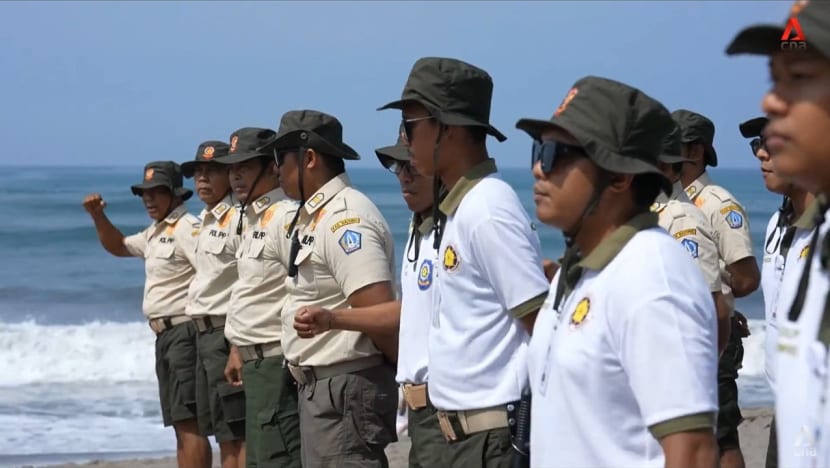
More than 70 tourism police officers have been deployed in popular districts, such as Canggu, Seminyak and Kuta.
Part of their job is also to ensure that tourists dress appropriately — for example, by wearing sashes provided — in the temples of Bali, the only Hindu enclave in Indonesia.
“Because of their ignorance, they don’t follow the rules when entering sacred places,” said Dharmadi.
In this slice of paradise, discontent is brewing. Last May, Bali’s then governor, Wayan Koster, proposed a cap on visitor numbers, citing misbehaving tourists as the reason.
Although the proposal did not materialise, the island continues to grapple with its status as Indonesia’s most popular tourist destination.
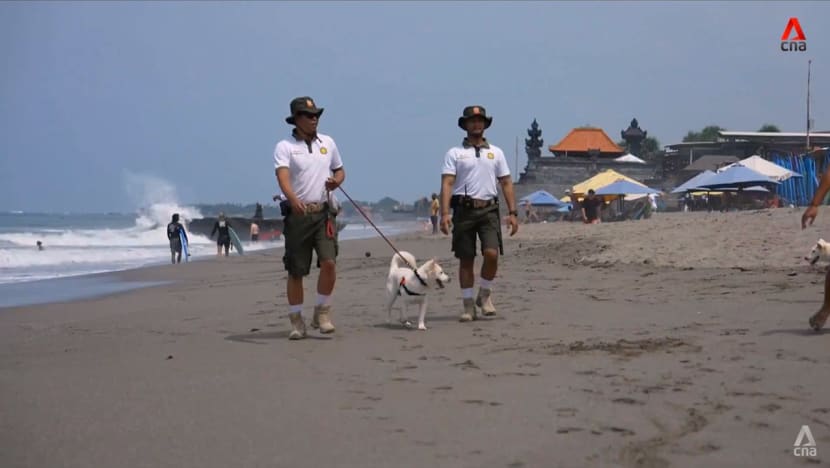
Last year, Bali deported 340 foreigners, up from 188 in 2022, mainly from Russia, the United States, the United Kingdom and Nigeria. Their violations included overstaying, working illegally and exposing themselves in sacred places.
In December, after a video of a payment dispute in a beauty salon went viral, two female tourists — an American and a Bermudian — were arrested for allegedly attacking salon staff, then deported in February, according to local police.
Earlier this year, police arrested three Mexicans for an alleged robbery that left a Turkish tourist wounded.
As travellers flock back to Bali after the pandemic, possibly in record numbers this year, the problem of overtourism has become more apparent than ever.
Related stories:

Indonesia’s Bali sees higher number of foreigners deported in 2023 than the year before

Visiting Bali soon? The resort island has issued a list of dos and don'ts for tourists
Still, Bali wants to have more visitors to make up for lost time, and lost tourism receipts, when the pandemic laid waste to its economy. In 2021, only 51 foreign tourists visited the island, compared with 6.3 million in 2019.
Last year, that number was close to 5.3 million, exceeding the target of 4.5 million. This year, Indonesia’s Tourism and Creative Economy Minister, Sandiaga Uno, has raised the benchmark to seven million, cited Bali tourism chief Tjok Bagus Pemayun.
“That’s quite high,” Tjok told the programme Insight . “Hopefully, we can reach the target because many airlines have added flights to Bali.”
CONCRETE CANGGU
The influx of tourists is not just giving rise to occurrences of misbehaviour, however. It is putting a strain on resources and tarnishing Bali’s image because of rampant development, overcrowding and gridlock.
WATCH: Bali’s love-hate relationship with tourism on Indonesian island paradise (46:24)
Bali made headlines in December when a traffic jam on a toll road forced people to walk up to four kilometres to the airport. There are also constant jams on roads leading to places of interest.
With a population of 4.5 million, how many tourists can the island accommodate, questioned Nyoman Sukma Arida, a vice dean of the tourism faculty at Bali’s Udayana University.
“Do we have enough land and water supply? Tourists need food and so on,” he said.
So far, things are left in a grey area, resulting in the influx of hotels, restaurants and so on. Permits are granted without questioning whether Bali has reached … overcapacity.”
The latest neighbourhood caught in a developmental dilemma is Canggu, after decades of tourist development spreading north from Kuta beach to Legian, then Seminyak.
There are now concrete buildings on every street in Canggu. Developers are attracted by its relatively cheap land prices. But the area is “suffering from massive traffic jams”, said Sukma, because “there’s no master plan”.
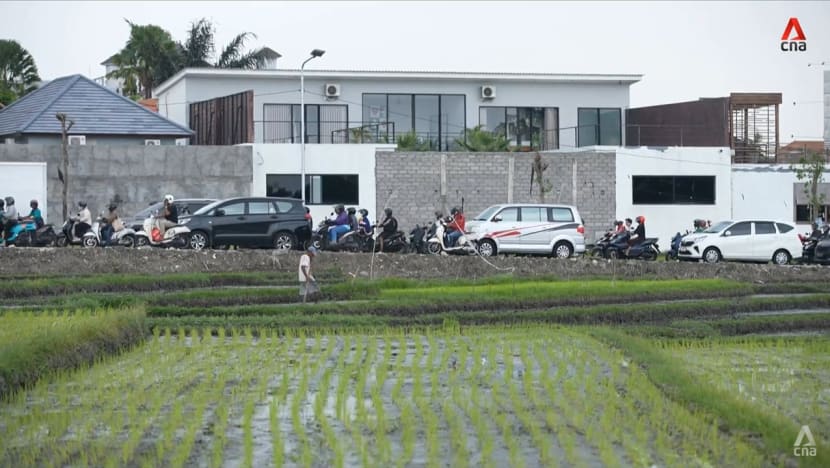
Locals such as traditional community chief Made Kamajaya, who was born and raised in Canggu, have a love-hate relationship with tourism.
“The local people’s economy is getting better,” he said. “(But) our surroundings have changed. You’re seeing destruction behind your house, in front of your house. … We’re dealing with uncontrolled development, of which almost 90 per cent disregards the environment.
“There’s no desire to plant trees. Waste management is non-existent.”
He is worried that “all the unregulated infrastructure projects will threaten tourism itself”.
WORLD HERITAGE SITE AT RISK
Even the rice terraces of Jatiluwih in central Bali — a Unesco World Heritage Site and one of the reasons tourists visit the island — are at risk of urban encroachment.
“There are always new developments,” said tour guide Wayan Kaung. “The process is slow. Usually, it starts with a small hut selling coconuts, and slowly it turns into a restaurant.”
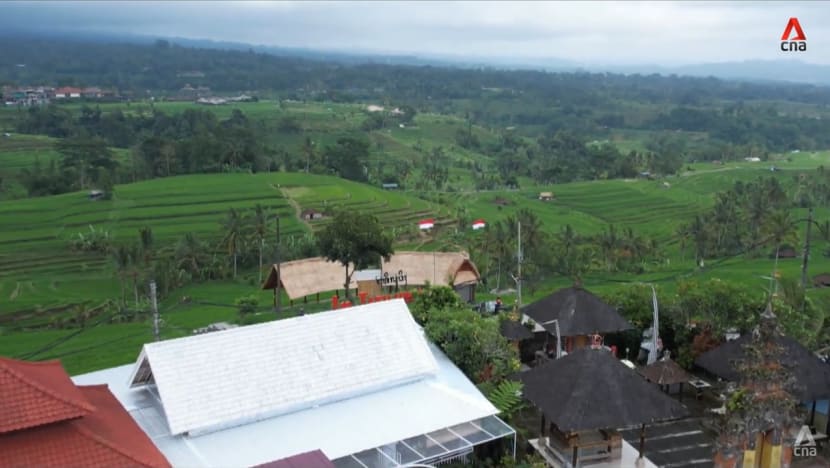
He brings tourists to Jatiluwih at least four times a week. Foreigners pay 50,000 rupiah (S$4.20) as an entrance fee, while Indonesians pay 15,000 rupiah.
“This is valid because I’ve seen rice field destruction near my home. There are many housing complexes, and the regulation of land conversion is unclear. So we must pay to protect something like this,” he said.
But it does not protect the rice fields completely. A 2018 report from the Amsterdam-based non-profit Transnational Institute estimated that Bali was losing 1,000 hectares (1,400 football fields) of agricultural land to development every year in the preceding 15 years.
According to a recent study by Udayana University agriculture professor Wayan Windia, the island is experiencing a deficit of 100,000 tonnes of rice per year.
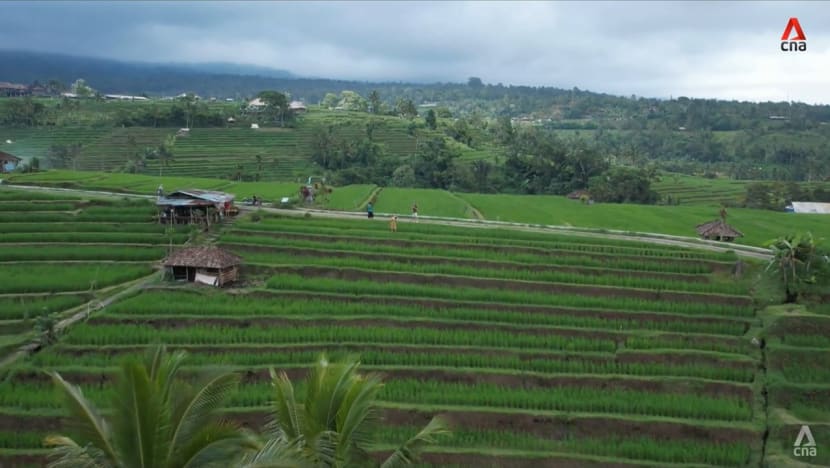
As much as 65 per cent of Bali’s groundwater goes to the tourism industry, drying up more than half of the island’s rivers and threatening sites such as Jatiluwih.
For some farmers, it is more lucrative to sell their land to developers than to eke a living in agriculture.
“So long as there’s a good view, there’ll be an opportunity to build villas,” said Kaung. “If one person sells his land for villa construction, others will jump on the bandwagon because of the access road.”
Some of the remaining farmers supplement their incomes by making handicrafts.
“Because of the opportunities offered by tourism, villagers work hard to make handicrafts. But they get only a small amount of money. It isn’t fair. That’s what we want to address,” said Agung Alit, the founder of Mitra Bali.

His social enterprise buys and sells handicrafts from these Balinese artisans.
“We invite the craftsmen to work together. We give a 50 per cent down payment, then when the goods arrive here, we check them, we select and pay cash,” he said.
The irony of the situation — that Bali is so dependent on the tourism said to be destroying the island — is not lost on him. “Tourism is ingrained in Bali,” he noted. “And it’ll be a challenge changing it.”
INDIGENOUS AND CULTURAL CONCERNS
Elsewhere, towards the north of Bali, Lake Tamblingan is becoming increasingly popular with tourists. It was formed from an ancient caldera, surrounded by a rainforest called Alas Mertajati.
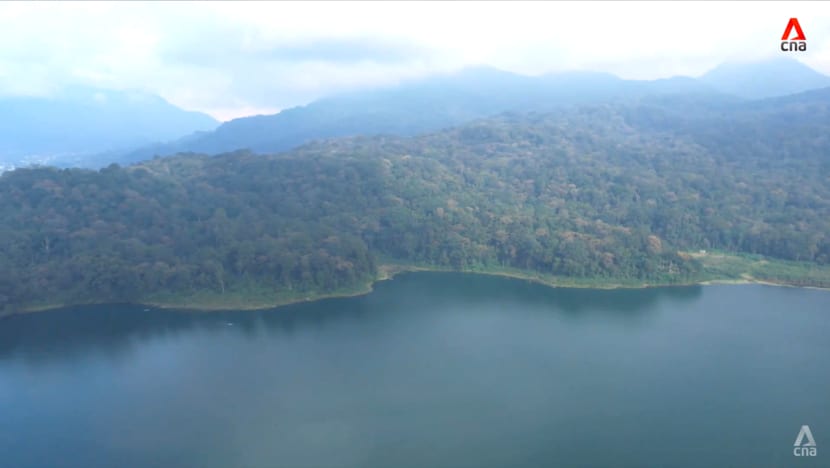
The lake and the forest help to protect water resources for the indigenous communities, who are mostly farmers. They grow coffee, oranges and vegetables.
The forest has a nature tourism zone, which allows investors, and a designated protected zone. “We’ve seen illegal logging, which affected the forest,” said indigenous leader Putu Ardana. “We don’t want that.”
He is working with the locals to protect the forest. They are lobbying the government to return stewardship of the forest to the villagers. To do so, the government must first recognise the indigenous tribes’ ancestral rights to the land.
Putu has some “harsh” criticism, however, of the government and of investors. “The government treats Bali like lucrative merchandise. Investors offer funds, and the government offers regulations, permits and so on,” he said.
“It shouldn’t be the concept of selling (but of) preserving.”
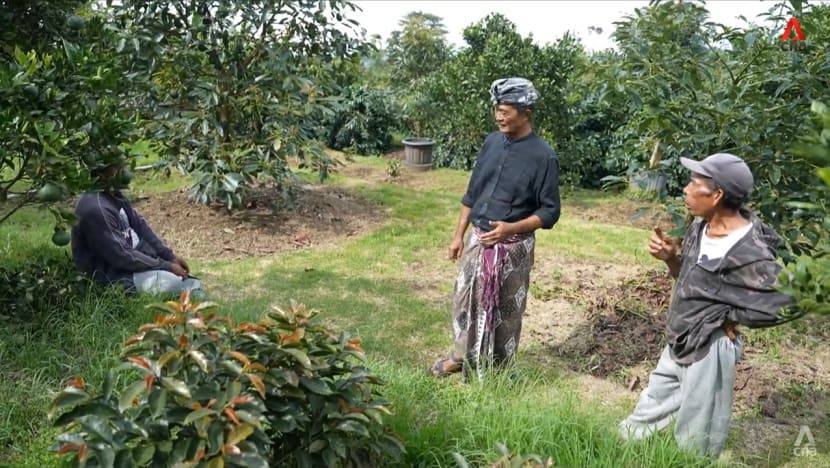
Culturally, tourism money and interest over the years meant more funds for the upkeep of temples and to hold traditional ceremonies. But some people question whether the pageantry loses its authenticity when put on for a show.
Rucina Ballinger, co-author of the book Balinese Dance, Drama and Music, calls it “cultural degradation” when there is “very little understanding” on tourists’ part.
“(On) the Balinese side, it’s when … they tell (visitors) to go and see these tourist performances, as opposed to ‘go to a warung — a little food stall — sit down, talk to the locals, have a cup of coffee and learn about their life,’” she said.
“Tourists are coming, and they’re … taking pictures. It’s an Instagram culture, it’s ‘let’s go to the beautiful spot’. And now all of these places are making Instagram spots for the tourists. And some people come here just to do that.”

For tourism consultant Lenny Pande, art, culture, tradition and the environment are the four pillars of tourism and are important “because those pillars exist in Hinduism in Bali”.
But she, too, has observed that “the preservation of those pillars is slightly diminishing” because of overdevelopment.
ENVISAGING A BETTER FUTURE
As concern over the impact of overtourism grows, the government has promised a more sustainable future for Bali.
Last July, outgoing governor Koster issued new guidelines on Bali’s development for the next 100 years (2025 to 2125), which cover the protection of nature, culture and the Balinese people.
For the first time, the government acknowledged the impact of mass tourism on Bali, citing land conversion, violations of sacred places, environmental damage and illegal businesses and activities as examples.
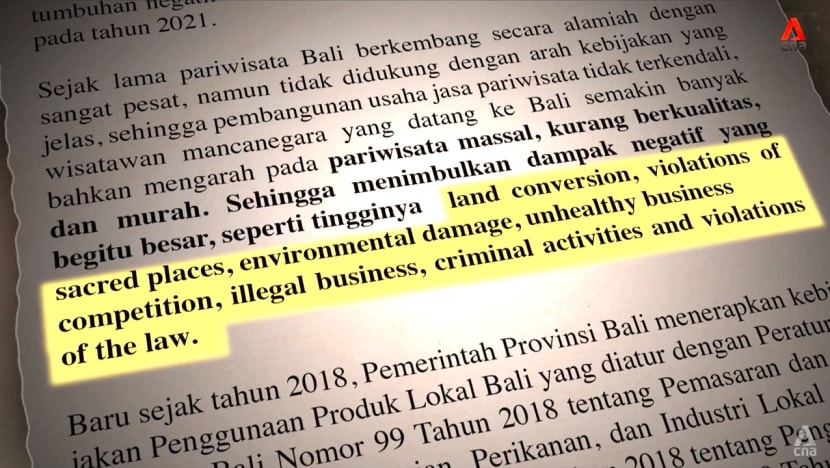
“One of the concerns is that Bali is being sold as a cheap tourist destination. Hopefully, we can minimise that so we can do better for Bali in future,” said Tjok from the local tourism authority.
“We want to have tourists who … respect Balinese culture. Secondly, we want tourists who are willing to stay longer. Hopefully, they’ll also spend more money.”
Since Feb 14, the government has levied a tourist tax of 150,000 rupiah. The revenue collected is meant to preserve Bali’s cultural heritage and protect its environment.
“The environment is our big house. The guidance from the top is to use the levy to deal with the waste problem,” said Tjok.
As for traffic management, the measures being taken include the construction of new underpasses. There are also plans for a Light Rail Transit system.
The forces of tourism may prove too strong, however, for some government plans.
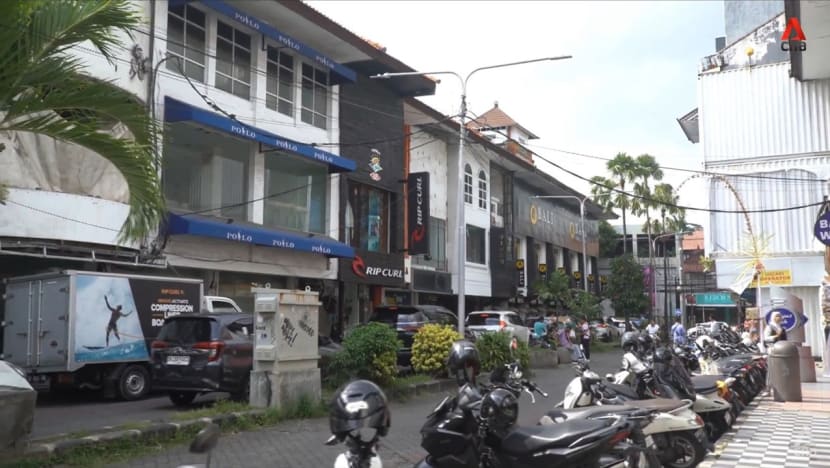
In January, a proposed entertainment tax of up to 75 per cent met with fierce resistance in the tourism industry. The steep tax has since been put on hold.
Last May, Koster announced a ban on tourist activities on all 22 of Bali’s sacred mountains, blaming tourist misbehaviour. But activities continued, and the ban is as good as axed.
With the lure of tourist dollars hard to resist for many, it could be up to local communities to preserve their way of life.
In the village of Penglipuran, in the east of Bali, a customary law forbids villagers to sell their land to outsiders. The traditional village is popular among Indonesian tourists, who pay an entry fee of 25,000 rupiah per person.

Tourists are allowed to enter family compounds to look around and buy snacks and souvenirs, so it can be intrusive.
But the money collected from visitors — up to 5,000 a day — has proven useful in protecting the culture and livelihood of the 1,100-plus villagers. During the pandemic, around 3 billion rupiah was distributed among them.
Deputy village chief Nyoman Setiawan is grateful that their culture is “still being upheld”. He said: “So long as our customs are strong, we’re convinced what happens to places like Denpasar, Kuta and Canggu won’t happen to us.”
Indonesia’s tourism ministry says the future of Bali lies in such small-scale, sustainable initiatives.
There is still a need, however, for authorities to first calculate “the carrying capacity of each zone and Bali as an island”, stressed Sukma the academic.
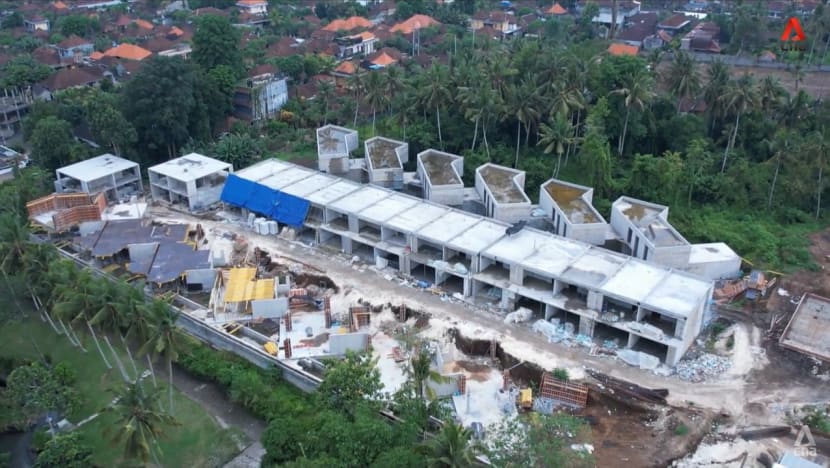
“Next, they must empower the local communities to be involved in controlling what happens in their areas,” he said. “The problem is the communities are … involved only when problems arise.”
As the post-pandemic revival of tourism continues at full steam for now, with every gridlocked motorway, every piece of rubbish thrown in the sea and every paddy field that disappears, a bit more of paradise is lost for some.
“Bali is doomed,” said Ballinger, who is married to a Balinese and has two sons and three grandchildren. “There’s no way that these concrete jungles can be turned back into rice fields … or into something that’s Balinese.”
With the growing attention on overtourism, however, some others see a chance for change.
“If we respect and preserve our culture, other people will be respectful,” said Sukma. “Perhaps it’s the Balinese who are complacent. This is my reflection.”
Watch this episode of Insight here . The programme airs on Thursdays at 9pm.
You may also be interested in:

Paradise island Lombok, its poisoned gold, and the children who suffer

On the Thai island of Phuket, sun, sea and Russians making waves
Related topics, also worth reading, this browser is no longer supported.
We know it's a hassle to switch browsers but we want your experience with CNA to be fast, secure and the best it can possibly be.
To continue, upgrade to a supported browser or, for the finest experience, download the mobile app.
Upgraded but still having issues? Contact us
- [email protected]
- +62 81 1195 6020
- Advertise with Us
- Write for Us
Home » Bali Tourism Recap 2023: A Year of Resilience and Sustainable Growth
Bali Tourism Recap 2023: A Year of Resilience and Sustainable Growth
- Fidyanita S
- 14:00, 15 Nov 2023
As we bid farewell to 2023, it’s time to reflect on Bali’s tourism industry, a sector that has demonstrated remarkable resilience, innovation, and commitment to sustainable growth in the face of global challenges. Bali, known for its famous areas such as Seminyak, Uluwatu, Canggu, and Kuta, is also well-known for its beautiful beaches, beach clubs and warm hospitality of Balinese. It has once again proven why it remains a top destination for travellers seeking a unique touristy part of Bali and an immersive experience.
Navigating Challenges Recap Bali, Indonesia
The year 2023 presented Bali’s tourism sector with unprecedented challenges, including the ongoing global pandemic and environmental concerns. However, the island’s resilience was evident as it adapted swiftly to changing circumstances. Stringent health and safety protocols were implemented to ensure the well-being of both tourists and locals, showcasing Bali’s commitment to prioritizing the health of its visitors.
Environmental Concerns and Sustainable Tourism
Bali faced heightened environmental concerns, ranging from plastic pollution to the preservation of its natural beauty. Acknowledging the importance of sustainability, the island took significant strides towards more eco-friendly practices. Initiatives such as beach clean-ups, plastic reduction campaigns, and sustainable tourism certifications for businesses aimed to mitigate the impact of tourism on Bali’s delicate ecosystems and promote responsible travel.
Plastic-Free Bali Campaign
Recognizing the pervasive issue of plastic pollution, Bali launched the “Plastic-Free Bali” campaign in 2023, a bold initiative aimed at reducing single-use plastics across the island. Hotels, restaurants, and businesses joined the movement by eliminating plastic straws, containers, and packaging . This applies to all tourists who visit or plan to go to Bali.
Rice Terrace Conservation and Sustainable Agriculture
Bali Island iconic rice field terraces in Ubud are a must-visit trip to Bali, a UNESCO World Heritage Site that faces environmental challenges due to changing agricultural practices. In response, the island implemented sustainable agriculture initiatives to preserve these cultural landscapes. Farmers adopted organic farming methods and upgraded irrigation systems to ensure water efficiency.
Economic Impacts and Community Support
The economic fallout of the global pandemic disproportionately affected Bali’s tourism-dependent economy. Businesses, particularly small enterprises, faced unprecedented challenges. However, the island exhibited a remarkable sense of community support. Local and international collaborations emerged to provide financial assistance, training programs, and initiatives to help businesses and individuals weather the economic storm, showcasing Bali’s solidarity and resilience.
Promotion and Branding in a Competitive Landscape
In the midst of global challenges, Bali faced the task of maintaining its position as a top travel destination. With increased competition, effective promotion and branding became essential. The island leveraged digital platforms, social media, and innovative marketing strategies to stay connected with potential visitors and maintain a positive image, showcasing Bali as a destination committed to safety, authenticity, and sustainability.
Digital Connectivity and Smart Tourism
Bali has embraced the era of smart tourism, offering tourists seamless digital experiences. From digital maps and guides to cashless transactions (QRIS) and contactless check-ins.
Collaboration with Influencers and Celebrities
Bali strategically collaborated with influencers and celebrities who aligned with the island’s values and target demographic. These partnerships extended beyond social media posts to include blog features, YouTube travel vlogs, and even participation in local events to have more people visit Bali.
Innovation in Tourism
Bali embraced technological advancements to enhance the overall tourism experience. The adoption of virtual reality (VR) and augmented reality (AR) technologies allowed potential visitors to explore Bali’s attractions virtually, providing a taste of the island’s beauty from the comfort of their homes. This innovative approach not only sustained interest in Bali during times of travel restrictions but also set the stage for a more digitally immersive future.
Virtual and Augmented Reality Experiences
Bali’s innovative leap into virtual and augmented reality has transformed how potential visitors explore the island. Tourists can now take virtual tours of iconic landmarks, immerse themselves in the local culture through AR-enhanced experiences, and even preview accommodations before making reservations.

Eco-Friendly Accommodations
Bali’s hospitality sector embraced the shift towards eco-friendly accommodations. Numerous hotels and resorts implemented sustainable practices, including the use of renewable energy sources, water conservation measures, and waste reduction initiatives.
Sustainable Tourism Initiatives Stay in Bali
Recognizing the importance of preserving Bali’s natural beauty, 2023 saw a significant increase in sustainable tourism initiatives. From eco-friendly accommodations to community-based tourism projects, stakeholders collaborated to ensure that tourism contributes positively to both the environment and local communities. This shift towards sustainability reflects a global awareness of the need to protect our planet, and Bali is at the forefront of this movement.
Cultural Experiences Around Bali
Despite challenges, Bali continued to offer unique cultural experiences side of Bali that set it apart from other destinations. Traditional dance performances, art exhibitions, and local festivals showcased the island’s cultural heritage. Visitors had the opportunity to engage with local communities, fostering a deeper understanding and appreciation for Bali’s rich traditions, such as traditional Balinese dance. Holistic Tirta Empul Temple and Tanah Lot Temple.
Adventure Tourism and Ecotourism
Bali’s diverse landscapes, from lush rice terraces to volcanic peaks, continued to attract adventure enthusiasts. The rise of adventure tourism and ecotourism activities, such as hiking, cycling, and wildlife excursions, allowed visitors to explore Bali beyond its famous beaches. This diversification of offerings satisfied the evolving preferences of tourists and contributed to a more sustainable and inclusive tourism model time in Bali trip.
As we reflect on Bali’s tourism journey in 2023, it is evident that the island has emerged stronger and more resilient than ever. Balancing innovation with traditional Balinese and growth with sustainability, Bali has set a benchmark for responsible tourism. The lessons learned and initiatives undertaken in 2023 provide a roadmap for the future Indonesian, ensuring that Bali remains a beloved destination for generations to come.
Find this article helpful? Check out other articles from Social Expat for more updates about Travel updates in Indonesia!
- Exploring Java Island, Indonesia: 10 Best Places to Visit For The Breathtaking Experience
- Explore Indonesia Trip on a Shoestring Budget: 2023 Travel Guide
- Experiencing Indonesian Arts: Batik Workshops and Traditional Artisans
I landed on a gold mine when I attended my first creativity thinking responsibility and the need to combine my knowledge of people and systems with my desire for problem-solving. I enjoy applying human-centered creative and creative thinking principles to create good writing that anyone can relax while reading.
See More Articles From Fidyanita Safitri >>
Related News
- Imelda Rahmawati
9 Best Canggu Beach Club to Visit in Bali 2024
Bali’s beaches are famous for their beauty and white sand beaches. It’s no wonder that many local and foreign tourists come here. However, if you want a more fancy vacation experience, visit Canggu. Canggu has now become one of the most densely populated tourist areas along the southwest coast of Bali, along with Seminyak, Legian, […]
Top Sights: Exploring Must-See Spots Around Jakarta Old Town (Kota Tua)
Jakarta Old Town, also known as Kota Tua. Here, time seems to slow down as you wander through cobblestone streets lined with magnificent Dutch colonial architecture. Immerse yourself in a bygone era as you explore iconic landmarks, delve into fascinating museums, and soak up the unique atmosphere of this Kota Tua Jakarta neighbourhood. Get ready […]
5 Must Visit Museums in Yogyakarta, Indonesia 2024
Yogyakarta is renowned for its enchanting natural beauty and its rich array of museum experiences that delve into the city’s history and culture. The city boasts numerous museums showcasing diverse themes, including history, art, and captivating exhibitions. What’s more, the entrance fees to these museums are highly affordable. For tens of thousands of rupiahs, visitors […]
- 2 weeks ago
Most Stunning Architecture Mosques in Indonesia
Indonesia, the world’s most populous Muslim nation, boasts a rich tapestry of cultures and architectural styles. This blend finds expression in its mosques, where grand designs and intricate details pay homage to faith and heritage. From the majestic Istiqlal Mosque in Jakarta to the award-winning Grand Mosque of West Sumatra, these houses of worship leave […]
Latest News
Update: hundreds of houses damaged by mount ruang eruption.
- 3 hours ago
Indonesian Steamed Dumplings ‘ Siomay ‘ Crowned as World’s Best Dumpling by TasteAtlas
- 5 hours ago
Melukat Ritual Proposed as Side Event at World Water Forum in Bali
- 9 hours ago
Funny Moments of Foreigner Bringing Children to Taste Typical Indonesian Snacks
Anthony kiedis, red hot chili peppers vocalist, relaxes in mentawai and eats lesehan, popular news, fatal accident on jakarta-cikampek toll road claims 12 lives, lila cita tavern, a premier destination for sports bar enthusiasts in nusa dua.
- 4 weeks ago
Indonesia Property Investment: Meet The Trendsetter of Property Mortgage for Expats
Kedonganan beach cleansed of 100 tons of trash with mass fish deaths.
- 1 month ago
Wealth Growth for the Expats: Investment Strategy and Tips
Kpu officially declares prabowo-gibran as the new president of indonesia for 2024-2029, subscribe to our newsletter.
Subscribe to our newsletter to get access to events, news, promotions and so much more!
- Expat Property
Immigration Corner
Expat event, jakarta expat networking, singles party at the elysium rooftop dining & lounge, jakarta, bali business networking at fairfield by marriott sunset road, bali, jakarta business networking at naaga bar, menteng.
- Indonesia Guide
Just For Fun
Write for us.
- Exclusive Promotions
- Event Gallery
The Gallery of Events
- Indonesian Visas
- Just for Fun
- Bellagio Mall, Jl. Mega Kuningan Barat Kav. E4 No. 3, Kuningan Timur Jakarta 12930
- [email protected]
Copyright © 2023. All Rights Reserved.
Powered by purple pineapple studio..
Matador Original Series

Bali Is Back With a More Local Experience Even Frequent Visitors Haven't Seen Before
V isitors who landed at Bali’s Denpasar airport in 2019, a year that welcomed more than six million international travelers to the island, were met with the picture of mass Bali tourism. Far from the serene, soul-stirring atmosphere promised in the pages of Eat, Pray, Love , a typical Bali vacation began with hours-long visa queues, a mire of stop-and-go traffic, and swarms of tourists seeking their social media-inspired photo op at all the major sights. It was becoming untenable, and came to an abrupt stop during the pandemic. According to the statistical research site Statista , the number of international arrivals dwindled to a scant 51 in 2021.
Now, after more than two years of a pandemic-induced slow-down, the Island of the Gods is back, but a lot has changed.
We hope you love the hotels we recommend! Just so you know, Matador may collect a small commission from the links on this page if you decide to book a stay.
Don’t be seduced by those dreamy, but dated, vacation photos on Instagram

Photo: Kaspars Grinvalds /Shutterstock
In some cases, tourists are booking hotel rooms based on beautiful online imagery, only to find the reality a bit lacking. Most hotels are severely understaffed, resulting in a lack of upkeep and shuttered spas, shops and restaurants.
Anne, an expat living in Canggu, shared with Matador a recent experience she had booking a dive resort near Amed in northeast Bali.
“We showed up just after dark, and the few staff that were still there seemed genuinely surprised to have guests,” she says. “The furniture was a bit in disrepair, the restaurant wasn’t operating so they offered to make a home-cooked meal, and my friend had a used towel left on the floor of her room. Still, these minor issues don’t outweigh the incredible experiences you can have right now exploring a quieter, crowd-free Bali.”
For example, Anne and her friends were able to dive the popular Liberty Wreck — one of Bali’s most popular dive spots – twice, with only one or two other dive groups present.
The takeaway? Expect more than a few steps down from five-star service at most boutique hotels and homestays. However, there are much better prices and you can expect a more relaxed and unfussy brand of hospitality. If you’re willing to splurge a little, you can still access higher-end and full-service accommodations at places like COMO Uma Ubud , the Andaz Bali in Sanur or Jimbaran Puri , a Belmond Hotel.
Regardless of where you stay, fewer crowds mean cleaner, quieter and less crowded sights and beaches , at least for now.
A more local approach to tourism

Photo: JomNicha /Shutterstock
These days, the people you do find on the beaches or in the warungs and cafes tend to be locals. Tara Hammond, the group sustainability coordinator for regional group travel outfit Asian Trails , is happy that Bali now caters more to the domestic tourism market, a move that has positive implications for the environment while also helping the industry become more resilient in case of future downturns.
“The tourism landscape of Bali has changed radically over the past few years,” says Hammond, explaining how many hotels, restaurants and points of interest have either shut down or shifted to offerings that attract domestic visitors as a way to keep the lights on.
“Sanur beach, for example, is now set up to cater to mostly local families and is no longer lined with endless rows of tourist deckchairs and loud jet skis,” she says. “Instead one can now find local eateries serving Indonesian staples like nasi goreng or nasi campur, and signs advertising kayaks and kites for rent.”
Even as foreign travelers return to Bali, local hospitality workers might be reluctant to shift their offerings to cater entirely to a foreign market. In such unpredictable times, domestic tourists offer much more dependable business.
A spectacle of mass tourism remains on display in Canggu

Photo: chaelinjane /Shutterstock
One slight exception to the slow-down is the ever-hip Canggu, which remains crowded with expats doing jobs like online coaching or being a crypto-entrepreneur. These are the lucky few who were living in Bali when the pandemic hit or those who were able to make it to Bali before travel restrictions.
Their alternative lifestyles converging in one city center makes Canggu an essential stop for the type of classes, workshops, and experiences one can only find in Bali. These go beyond your typical sound healing or breathwork sessions to include things like ecstatic dance, which is an hour of sober solo dancing where participants are encouraged to surrender their bodies and minds to “flow” through spontaneous movement. Or Shabari workshops, where participants can expand their sexual kink to include this ancient Japanese rope-tying tradition, or simply pay for the privilege to maintain eye contact and hold hands with a complete stranger for an hour or so.
For all its charming coffee houses, trendy co-working spaces and decadent nightclubs, however, Canggu remains the place with some of the least desirable aspects of Bali still on display — including gridlock traffic and piles of plastic trash washing up on the beaches during the rainy season.
How tourists can help Bali achieve a better way forward
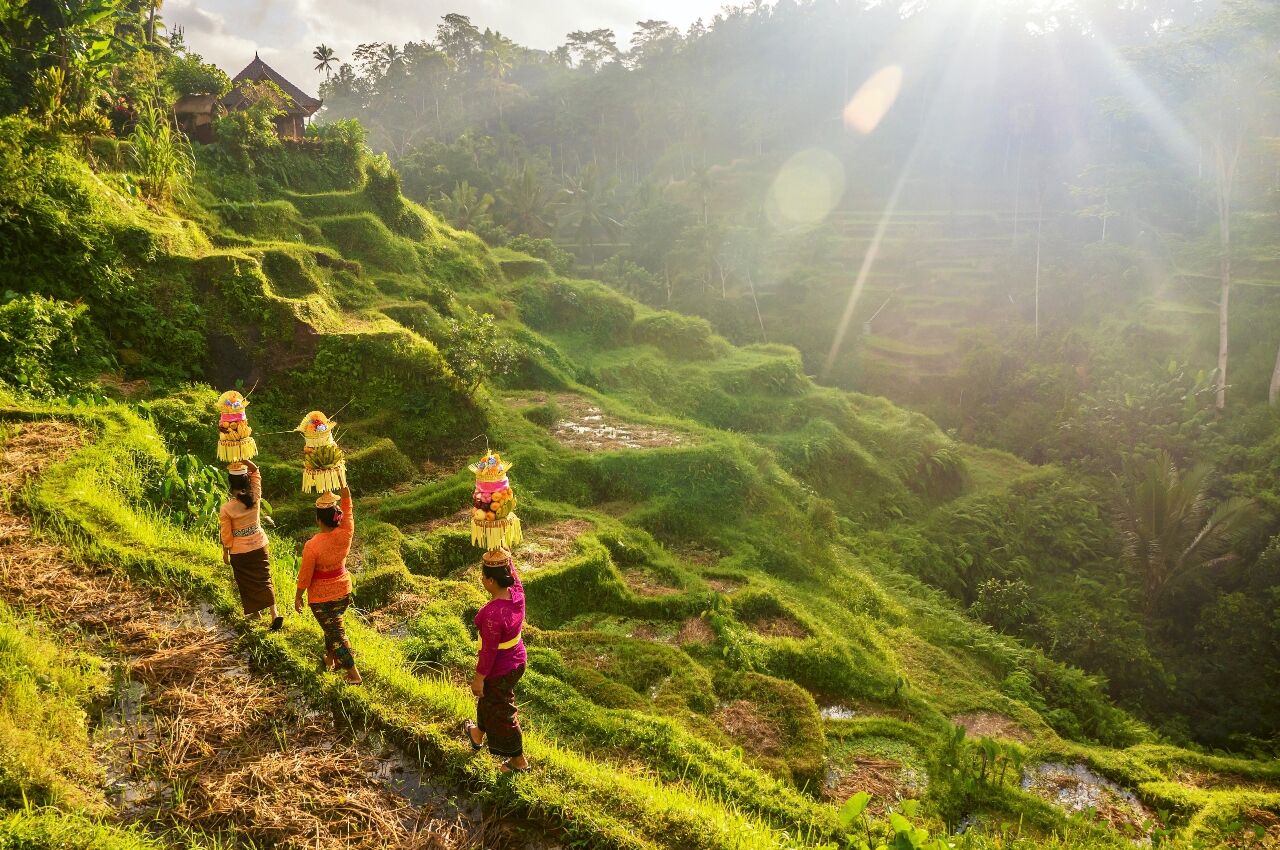
Photo: CherylRamalho /Shutterstock
If we are going to prevent the plague of mass tourism from reaching beyond Canggu into every part of peaceful Bali, future visitors will need to make intentional choices to protect the island’s environment and its people.
Piet Van Zyl, a travel industry sustainability consultant and chief regenerative officer for Selo Group , believes Bali’s reopening is a unique opportunity for the tourism industry to find a better path forward. Van Zyl, who has spent many years living on the island, witnessed first-hand how the pandemic devastated locals whose livelihoods depended on tourism, which accounts for about 80 percent of Bali’s economy. Going forward, he hopes visitors will do more to ensure locals are looked after.
“Before, people came to Bali to have sun and sea and fun and parties,” he says. “But people coming today should really engage more with the local people and the local culture. They should be asking questions about how an establishment is taking care of its water supply and land as well as the community within which it is operating.”
Van Zyl reflects on how, even as Balinese communities lost their main source of income, they never lost their famous friendliness. It’s one of the many reasons he hopes future tourists will consider whether their planned activities are helping or harming the environment and the Balinese who live here, and adjust accordingly.
“Make sure that wherever you’re going, you are taking care of and learning about the locals,” he says. “Attend ceremonies, take a cooking class, or speak with shop owners selling handcrafted wares. When you know a community, you can care for that community.”
More like this
Trending now, how a bali farm makes some of the world’s most expensive coffee with the help of palm civet poop, why a high-powered ceo left the corporate world to create a retreat in bali, exploring bali's incredible street food culture with the 'street food chef' himself, discover matador, adventure travel, train travel, national parks, beaches and islands, ski and snow.
Bali’s Tourism Statistics: Insights from January 2024
- Written by Armel Theurillat
- March 28, 2024

According to the latest data unveiled by the Bali Central Bureau of Statistics on the 1st of March 2024, the influx of foreign tourists reached 420,037 visits during January 2023 .
This signifies a decrease of -12.79% compared to December 2023 .
Overall in 2023 , a number of 5,273,258 foreign visitors deliberately chose Bali as their ultimate destination.
For a comprehensive breakdown of these figures, please refer to the enlightening comparison presented below:
Exploring Foreign Tourist Visits to Bali: An Analysis of the Past 12 Months
After examining the data from January to December 2023, here’s a breakdown of tourist trends in Bali:
Visitor Highlights in 2023:
The average number of foreign visitors per month is approximately 439,438 visitors .
The minimum number of visitors in a month was 323,623 (February 2023) .
The maximum number of visitors in a month was 541,353 (July 2023) .
High Season: July 2023 saw a high number of visitors, indicating that this month might be part of the high tourist season for Bali.
Dips: There’s a noticeable dip in visits in November 2023. The reason for November’s decline requires further investigation.
2023 Overview:
In the year 2023 , Bali played host to 5,273,258 international visitors , representing a +144.61% increase compared to the 2022 period.
This underscores Bali’s resilient tourism rebound and its enduring magnetism on the global stage.
Tourist Visit Data from Airport and Port Arrivals for the Last 3 Months
Upon further exploration of the BPS data, we can divide these figures into two entry point as can be seen below:
Countries Contributing the Most Tourists to Bali in January 2024
Bali experienced an increase in visitors during the month of January 2024, as reported by BPS.
We saw travelers from Australia, China, India, South Korea, United Kingdom, Russia, United States, Malaysia, Singapore, and Germany flocking this captivating island, creating a vibrant tapestry of global travelers.
A Glimpse into January 2024’s Tourism Figures:
- Almost all top 10 countries experienced a decrease in visitor’s number compared to the previous month.
- In January 2024, Chinese visitors recorded a quite significant increase with +32.49% compared to December 2023.
- In January 2024, the number of visitors from Singapore and Malaysia dropped significantly.
In summary, these observations offer a glimpse into the changing dynamics of Bali’s tourism landscape.
Also read which countries contribute to Bali’s tourism from 2014 until 2022
Top 10 Countries Contributing the Most Tourists to Bali in Januari 2024
The Statistical Report released by the Central Bureau of Statistics sheds light on the key contributors to Bali’s bustling tourism scene in January 2024.
Analyzing the data reveals the top ten countries that generated the highest influx of foreign tourists during this period.
1. Australia
Despite a -5.81% decrease in visits compared to December 2023, Australia maintains a significant share of 27.75% of total visits to Bali in January 2024 with 116,580 visits.
With a remarkable +32.49% increase in visits, China’s share rises to 8.75% of total visits in January 2024 with 36,766 visitors.
Despite a substantial -32.99% decrease in visits, India still holds a notable share of 7.42% of total visits to Bali in January 2024 with 31,169 visits.
4. South Korea
With a steady increase of +19.82% in visits, South Korea maintains a share of 5.84% of total visits to Bali in January 2024 with 24,536 visitors.
5. United Kingdom
Despite a slight decrease of -9.31% in visits, the United Kingdom retains a share of 4.24% of total visits to Bali in January 2024 with 17,798 visitors.
With a modest increase of +10.07% in visits, Russia maintains a share of 4.18% of total visits to Bali in January 2024 with 17,560 visits.
7. United States
Despite a decline of -13.48% in visits, the United States still holds a share of 3.89% of total visits to Bali in January 2024 with 16,337 visitors.
8. Malaysia
Experiencing a significant decrease of -43.04% in visits, Malaysia’s share declined to 3.15% of total visits to Bali in January 2024 with 13,222 visits.
9. Singapore
With a drastic decline of -71.97% in visits, Singapore’s share decreases to 2.53% of total visits to Bali in January 2024 with 10,638 visitors.
10. Germany
With a slight increase of +1.66% in visits, Germany maintains a share of 2.40% of total visits to Bali in January 2024 with 10,070 visits.
After reading this data-driven article from us, we hope you can unlock Bali’s vast tourism potential and ignite your passion for investing in property on the island.
Explore the possibilities, seize the moment, and embark on a rewarding journey of property investment in Bali .
References:
Data taken from Bali Central Bureau Statistics
6 Reasons Why Bali is the Most Popular Destination in the World (Travelers Choice – Best of the Best)
Countries that Visits Bali the Most from 2014-2022
The Rising Trend of Luxury Villa Rentals in Bali: A Look at the High-End Market

Sign up your property now to become the part of Bali Management Villas’ family and maximize your profits with us!
- Jalan Raya Kerobokan No. 5x, Badung Bali 80361
- +62 (361) 9342 033
- [email protected]
Copyright © 2024. Bali Management Villas.
- Bahasa Indonesia
- Latest News
- Popular News
- Business & Investment
BI projects tourism-driven economic growth in Bali in 2023
- December 29, 2022 19:11 GMT+700
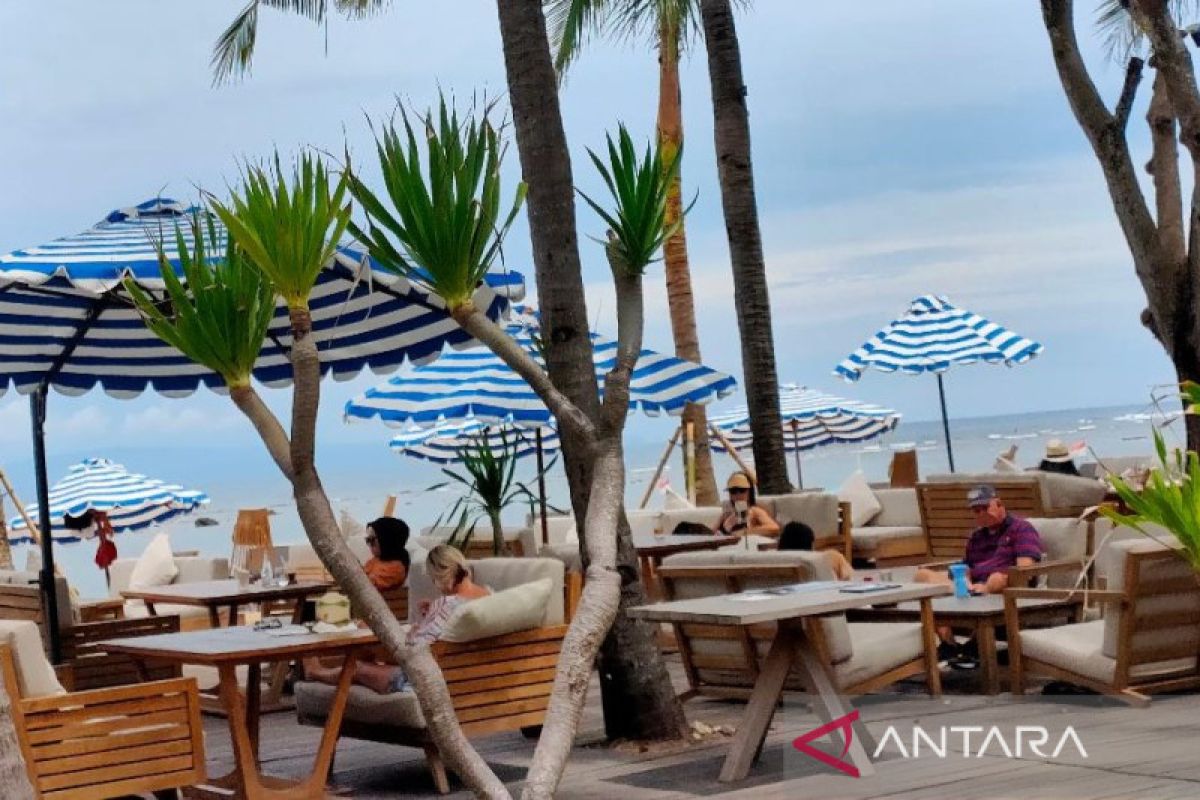
Translator: Ni Luh Rhismawati, Raka Adji Editor: Rahmad Nasution Copyright © ANTARA 2022
- economic growth
Related News

BI, RBI agree to use local currencies for bilateral transactions
- 7th March 2024

Indonesia must remain optimistic, vigilant: BI Governor
- 5th March 2024

Indonesian economy sees solid growth in Q4 2023: BI
- 6th February 2024

Need to improve synergy of economic policy mix: BI
- 31st January 2024

Maintain consumption, investment to support economy in 2024: BI

Indonesia's economic recovery continues: BI
- 17th January 2024

Indonesia's economy grows well with domestic demand's support: BI
- 21st December 2023

QRIS saved Indonesia from crisis during pandemic: BI Governor
- 30th November 2023

Indonesia's economy projected to grow by 5.3-6.1 pct in 2028: BI

Digital payments accelerate digital economic growth: BI
- 28th November 2023

Gen Z, Gen X support domestic economic growth: Bank Indonesia
- 11th November 2023

BI office in Nusantara to boost business sector confidence: Widodo
- 2nd November 2023

IMAGES
VIDEO
COMMENTS
Officials in Bali have come together to discuss the future of tourism on the island. As leaders have been calling for a shift towards more sustainable and culturally respectful tourism, following a rise in badly-behaved foreigners in 2023, there is an opportunity for Bali to redefine what cultural tourism means in practice.. At a summit titled 'Continuous Bali Tourism Development Meeting ...
In 2019, Indonesia welcomed 16.1 million foreign tourists, according to data from the country's central bureau of statistics. Bali's Ngurah Rai International Airport saw 6.23 million foreign ...
Tourism is the backbone of Bali," said Hujan Locale's manager, Kadek Miharjaya. Bali, Indonesia's main tourism hotspot, drew more than 6 million travellers in 2019.
According to a survey the group conducted, digital nomads in Bali currently make around USD$3,000 a month, spending between USD$250 and USD$1,000 on accommodation and USD$140 and USD$700 on food per month. Beyond Bali, the petition mentions the potential for other areas of Indonesia—part of the government's "10 New Bali's" tourism ...
A view from the reception area of the Apurva Kempinski Bali. Aren Elliott. Bali is in the middle of a tourism boom. New hotels are opening, visitors are arriving in near-record numbers — and ...
COVID-19 has hit tourism-reliant destinations hard.The Indonesian island of Bali, for example, where 70% of the population depend on tourism, has seen extensive job and income losses since it ...
Bali's tourism industry is at a pivotal point, with sustainability at its core. These initiatives not only enhance the visitor experience but also ensure the preservation of Bali's natural beauty and cultural heritage for future generations. As we navigate this exciting journey, the potential for a more responsible and sustainable tourism ...
In 2020, 236,000 people in Bali worked in the tourism sector, compared with 328,000 the previous year, according to data from Indonesia's Ministry of Tourism and Creative Economy. That number is ...
Tourism Targets for 2023. Minister Sandiaga said that the target for domestic and international tourists in 2023 is projected to double the current performance. For international tourists in 2023, Indonesia aims to welcome 7.4 million visitors, while domestic travelers are expected to hit between 1.2 and 1.4 billion movements.
10 November 2021. Jakarta - Chairman of the Bali Hotels Association Jean Hélière predicts that the global market for the domestic tourism industry will recover around 2024 to 2025. Jean said tourism businesses in Bali are still focused on maximising income from local tourists as a number of community activity restrictions are relaxed.
Still, Bali wants to have more visitors to make up for lost time, and lost tourism receipts, when the pandemic laid waste to its economy. In 2021, only 51 foreign tourists visited the island ...
The year 2023 presented Bali's tourism sector with unprecedented challenges, including the ongoing global pandemic and environmental concerns. However, the island's resilience was evident as it adapted swiftly to changing circumstances. Stringent health and safety protocols were implemented to ensure the well-being of both tourists and ...
At the end of May, Bali Governor I Wayan Koster quashed speculation on when Bali would reopen, stating there were no plans to restart the tourist industry in the near future. As reported by Kompas ...
Every year, Indonesia sets ambitious targets for international tourist arrivals, and Bali consistently outperforms expectations, solidifying its status as a premier travel destination. In 2023 ...
Bali and Beyond Travel Fair (BBTF) committees announced the readiness to conduct this well-positioned Indonesia's leading International Travel Fair by launching its 9th edition's logo and the theme of BBTF 2023: "Reconnecting to quality and Sustainable Tourism". This annual event will be held in June 14-17, 2023 at the Bali International Convention Centre (BICC), Nusa Dua.
Abstract. This research aims to systematically review of literature on Bali tourism from. 1976 to 2022. This study employed a descriptive quantitative approach and. utilizes 128 publications with ...
V isitors who landed at Bali's Denpasar airport in 2019, a year that welcomed more than six million international travelers to the island, were met with the picture of mass Bali tourism. Far from the serene, soul-stirring atmosphere promised in the pages of Eat, Pray, Love, a typical Bali vacation began with hours-long visa queues, a mire of stop-and-go traffic, and swarms of tourists ...
March 28, 2024. Bali played host to 420,037 international visitors in January 2024, marking a -12.79% decrease from December 2023. Dive into more detailed Bali tourism data here! According to the latest data unveiled by the Bali Central Bureau of Statistics on the 1st of March 2024, the influx of foreign tourists reached 420,037 visits during ...
In response to market demand, BBTF will showcase and promote sustainable tourism products for a responsible future. Further, particular focus is also being given to health, emphasizing the current growth of the wellness and medical tourism industry as well as community-based tourism. Business contracts to be generated within one year during our ...
Denpasar, Bali (ANTARA) - The Bali Representative Office of Bank Indonesia (BI) has projected Bali's economic growth in 2023 to still be driven by increased business performance related to tourism and several construction projects in the province. "The business fields related to tourism are accommodation and food and beverage and then ...